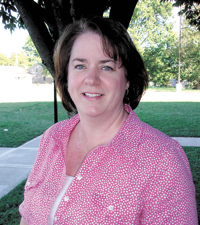Cindy Kearns: Adapting To Meet Students Needs
 To the casual observer, not much has changed for Cindy Kearns in the past quarter of a century.
To the casual observer, not much has changed for Cindy Kearns in the past quarter of a century.
Just like her first day on the job in 1990, Kearns teaches fifth grade – in the same classroom – at Nicholasville Elementary. It’s a school she attended as a sixth-grader when her family moved to Nicholasville.
Except for her college years, Cindy has never left, raising three children in Nicholasville, all of whom she taught in fifth grade.
So is everything the same?
“Absolutely not,” Kearns said.
“I’m a completely different teacher than I was back then. I’m so much more confident, and I’ve taken on math leadership roles at the school.”
At first, Kearns was the rookie, surrounded by a veteran staff. As the years passed, she looked up and discovered she was the veteran, coaching younger teachers, counseling
student teachers and serving as mentor to new hires through the Kentucky Teacher Internship Program (KTIP).
Brittany Worthen, a fellow fifthgrade teacher in her sixth year at the school, still relies on Kearns.
“Cindy was my KTIP resource teacher, and she made me what I am today,” Worthen said. “She’s so encouraging and an example of what a quality teacher should be.”
Part of that means constantly adapting to meet the needs of children.
Kearns may teach in the same classroom, but nearly everything else has changed since her first year.
:::::::::::::::::::
Nominate Your Teacher
Smart Boards have replaced blackboards, and Kearns demonstrates new concepts with a document camera that projects on the Smart Board. As the technology has
evolved, so has Kearns’ methods.
“How I teach is so much more conceptual than before,” she said.
Previously, the state required teachers to cover so much content, there was little time for depth of understanding. With the advent of the Common Core Initiative three
years ago, Kearns can teach to understanding rather than rote memorization – a much more effective approach, she said.
“When you’re teaching to understanding, a student may forget the procedure but, because he or she understands the process, they can still solve the problem,” she said.
“That makes teaching so much more gratifying.”

